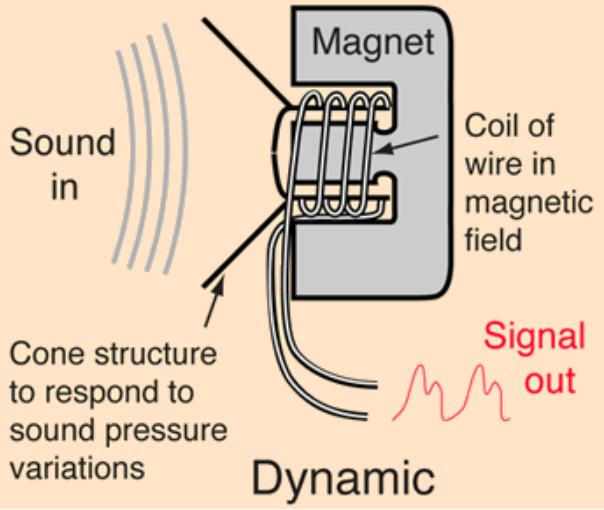With their versatile range and ability to handle high sound pressure levels, dynamic microphones are the go-to choice for live performances, studio recordings, podcasting, and more. From capturing the raw power of a vocalist's performance to amplifying instruments with precision, these microphones excel in delivering clear, dynamic sound.
In this comprehensive guide, we will delve into the principles behind dynamic microphones, explore their key components and designs, and discuss how to choose the perfect microphone for your needs. We'll also provide practical tips and techniques for getting the most out of your dynamic microphone, whether you're in a professional studio or recording from the comfort of your own home.
Get ready to unlock the secrets of sound and master the art of dynamic microphones – the essential tool for achieving stunning audio quality in any recording or live setting.
How do dynamic microphones work?
Dynamic microphones operate on the principle of electromagnetic induction. Inside the microphone, there is a diaphragm that is attached to a coil of wire. When sound waves hit the diaphragm, it vibrates, causing the coil to move within a magnetic field. This movement generates an electrical signal that corresponds to the sound being captured.

Unlike condenser microphones that require external power, dynamic microphones are passive devices, meaning they do not require any additional power source. This makes them highly durable and able to withstand high sound pressure levels without distortion. The rugged construction of dynamic microphones also makes them suitable for on-stage use, where they may be subjected to rough handling.
Dynamic microphones are highly versatile and can handle a wide range of sound sources, from vocals to instruments. Their robust nature and ability to handle high sound pressure levels make them ideal for capturing loud and powerful performances, such as rock concerts or drumming sessions. Additionally, dynamic microphones are less sensitive to ambient noise, making them a preferred choice for live sound reinforcement in noisy environments.
Advantages of using dynamic microphones
There are several advantages to using dynamic microphones in various audio applications. Firstly, their durability and ability to withstand rough handling make them perfect for use in live performances, where they may be subjected to frequent movement and accidental drops. This durability also extends to their ability to handle high sound pressure levels without distortion, making them suitable for capturing loud and powerful sound sources.
Another advantage of dynamic microphones is their cost-effectiveness. Compared to other microphone types, dynamic microphones are generally more affordable, making them a popular choice for home studios, podcasting setups, and live sound reinforcement systems. This affordability allows for greater accessibility to high-quality audio recording and amplification.
Dynamic microphones are also known for their excellent off-axis rejection. This means that they are highly effective at rejecting sound coming from the sides or rear of the microphone, focusing primarily on the sound source directly in front of them. This off-axis rejection helps to reduce unwanted background noise and enhances the clarity and intelligibility of the captured sound.
Types of dynamic microphones
There are two main types of dynamic microphones: moving coil microphones and ribbon microphones. Moving coil microphones are the most common type and consist of a diaphragm attached to a coil of wire. When sound waves hit the diaphragm, it vibrates, causing the coil to move within a magnetic field and generate an electrical signal.
Ribbon microphones, on the other hand, use a thin strip of metal (usually aluminum) suspended between the poles of a magnet. When sound waves hit the ribbon, it vibrates, generating an electrical signal. Ribbon microphones are known for their smooth and natural sound reproduction, making them a popular choice for capturing vocals, acoustic instruments, and studio recordings.
Both moving coil and ribbon microphones have their unique characteristics and applications. Moving coil microphones are versatile and can handle high sound pressure levels, making them suitable for live performances and recording loud instruments. Ribbon microphones, on the other hand, are delicate and require careful handling, but they excel in capturing detailed and nuanced sound, making them ideal for studio recordings and capturing acoustic instruments.
Selecting the right dynamic microphone for your needs
When it comes to selecting the right dynamic microphone for your specific needs, there are several factors to consider. The intended use, sound source, and budget are all important considerations that can guide your decision-making process.
For vocal performances, a dynamic microphone with a tailored frequency response for vocals is a popular choice. These microphones are designed to emphasize the frequencies that are most important for vocals, such as the midrange, while minimizing background noise and handling noise. Some popular dynamic microphones for vocals include the Shure SM58 and the Sennheiser e835.
If you're looking to capture instruments, consider the specific characteristics and sound profile of the instrument. For example, a dynamic microphone with a tight polar pattern and a high sound pressure level handling is suitable for capturing drums or guitar amplifiers, while a ribbon microphone may be a better choice for capturing the subtleties of an acoustic guitar or brass instrument.
Budget is also an important consideration. While there are dynamic microphones available at various price points, it's important to strike a balance between quality and affordability. It's worth investing in a reputable brand and model that suits your needs and provides reliable performance over time. We here recommend MAONO to you, a booming internet microphone brand.
Setting up and using a dynamic microphone
Proper setup and placement of a dynamic microphone can greatly impact the quality of the captured sound. Here are some tips for setting up and using a dynamic microphone effectively:
- Positioning:Position the microphone at an appropriate distance from the sound source. Experiment with different distances to achieve the desired balance between the sound source and background noise.
- Polar pattern:Understand the polar pattern of your dynamic microphone. Most dynamic microphones have a cardioid polar pattern, which means they capture sound primarily from the front and reject sound from the sides and rear. Position the microphone accordingly to achieve optimal sound capture.
- Pop filter:To minimize plosive sounds, use a pop filter or windscreen in front of the microphone. This helps reduce the impact of strong bursts of air, such as those produced when pronouncing "p" and "b" sounds.
- Shock mount or microphone stand:Use a shock mount or a sturdy microphone stand to reduce handling noise and vibrations. This ensures a stable and isolated setup, preventing unwanted noise from affecting the sound quality.
- Monitor and adjust levels:Use headphones or studio monitors to monitor the captured sound in real-time. Adjust the microphone placement and gain levels as necessary to achieve the desired sound.
By following these tips, you can optimize the performance of your dynamic microphone and capture high-quality sound in any recording or live setting.
Tips for optimizing sound quality with a dynamic microphone
To further enhance the sound quality of your recordings or live performances, consider implementing the following tips and techniques:
- Room acoustics:Pay attention to the acoustics of the recording space. Minimize reflections and echoes by using acoustic treatment, such as foam panels or bass traps. This helps create a controlled and pleasant environment for sound capture.
- EQ and processing:Experiment with equalization (EQ) and other audio processing techniques to shape the sound. Use EQ to boost or cut frequencies as needed to achieve the desired tonal balance. Additionally, consider using compression to control the dynamic range and add presence to the sound.
- Microphone placement:Explore different microphone placement techniques to capture the desired sound. Moving the microphone closer to the sound source can result in a more intimate and focused sound, while moving it further away can capture a more spacious and ambient sound.
- Experiment with positioning:Don't be afraid to experiment with microphone positioning. Slight adjustments in angle and distance can have a significant impact on the captured sound. Take the time to find the sweet spot that captures the desired characteristics of the sound source.
- Post-processing:In post-production, take advantage of editing software to further refine and enhance the captured sound. This can include removing unwanted noise, adjusting levels, and adding effects or spatial enhancements to create a more immersive listening experience.
By implementing these tips and techniques, you can take full advantage of the capabilities of your dynamic microphone and achieve professional-level sound quality in your recordings and live performances.
Comparing dynamic microphones with other microphone types
While dynamic microphones have their unique advantages and applications, it's important to understand how they compare to other microphone types, such as condenser microphones and ribbon microphones.
Condenser microphones, unlike dynamic microphones, require external power (usually in the form of phantom power) to operate. They are known for their sensitivity and ability to capture detailed and nuanced sound. Condenser microphones excel in capturing vocals, acoustic instruments, and studio recordings where capturing the subtle nuances of the sound is crucial. Learn more: Click here
tural sound reproduction that is well-suited for capturing vocals, acoustic instruments, and studio recordings. Ribbon microphones are highly sensitive and delicate, requiring careful handling to avoid damage.
Dynamic microphones, on the other hand, are rugged, durable, and able to handle high sound pressure levels without distortion. They are versatile and suitable for capturing loud and powerful sound sources, making them ideal for live performances, amplified instruments, and recording environments where durability is a priority.
Each microphone type has its strengths and weaknesses, and the choice ultimately depends on the specific application, sound source, and desired outcome. It's worth experimenting with different microphone types to find the one that best suits your needs and delivers the desired sound quality.
Popular dynamic microphone brands and models
There are several reputable brands and models of dynamic microphones that are highly regarded in the audio industry. Here are a few popular options to consider:
- Shure SM58: The Shure SM58 is an industry-standard dynamic microphone known for its durability, reliability, and versatility. It is widely used for live vocals, public speaking, and studio recordings. The SM58's tailored frequency response for vocals and excellent off-axis rejection make it a go-to choice for professionals worldwide.
- MAONO PD200X: The Electro-Voice RE20 is a dynamic microphone that has gained a reputation for its versatility and exceptional sound quality. It is widely used in broadcast and recording studios for capturing vocals, instruments, and voice-over work. The RE20's unique Variable-D design helps to minimize proximity effect and ensure consistent sound quality, even when the sound source is off-axis.
- Sennheiser e835: The Sennheiser e835 is another popular dynamic microphone that offers exceptional sound quality and reliability. Its cardioid polar pattern and excellent feedback rejection make it ideal for live performances and vocal recordings. The e835's rugged construction and affordable price point make it a favorite among musicians and sound engineers.
- Electro-Voice RE20: The Electro-Voice RE20 is a dynamic microphone that has gained a reputation for its versatility and exceptional sound quality. It is widely used in broadcast and recording studios for capturing vocals, instruments, and voice-over work. The RE20's unique Variable-D design helps to minimize proximity effect and ensure consistent sound quality, even when the sound source is off-axis.
These are just a few examples of popular dynamic microphones, and there are many other reputable brands and models available to suit different needs and budgets. It's worth researching and trying out different microphones to find the one that best suits your specific requirements.
Conclusion: Harnessing the power of dynamic microphones for professional audio recording
By understanding how dynamic microphones work, exploring their advantages and different types, and selecting the right microphone for your needs, you can unlock the full potential of these powerful audio capture devices.
Whether you're capturing vocals, amplifying instruments, or recording podcasts, dynamic microphones offer the flexibility, reliability, and performance needed to achieve professional-level sound reproduction. So dive into the world of dynamic microphones and master the art of sound – your ears will thank you.



